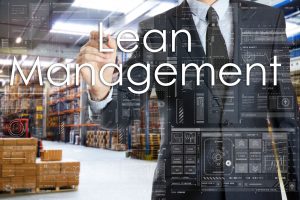
Developing a Lean culture with a Lean Management system developed in parallel with the Lean process system ensures that the roles, processes, standards, and procedures are documented and followed. Although we are not discussing physics, the law of entropy applies. It states “Organized systems tend to move toward disorganization”. Lean involves the adoption of new processes, work habits, and the use of new tools. Everyone must learn new habits and, as psychologists say, extinguish the old habits. It is so easy to fall back into old habits. They lurk in the back of our mind waiting for the opportunity to resurface. This propensity of old habits to re-occur is the reason why a management system must be developed and implemented in parallel with the process system.
The Value of a Lean Management System
A Lean management system will provide the tools and processes to maintain and support the Lean process system. It will sustain the integrity of your system and ensure you realize the benefits of Lean. A management system will close the loop on processes and allow employees to make continuous improvements. A Lean production system and a Lean management system are interrelated.
For example, a manufacturing company instituted Lean and standardized processes in a major area. They developed a flow for the work and cross-trained employees and immediate supervisors so that flow could be maintained. The implementation resulted in a faster product delivery, reduction in time and costs, and an increase in product quality. But then management focus changed to the latest new technology, employees were transferred to other areas or moved up or out and new employees were not provided cross-training or Lean training. Gradually, the employees became less disciplined with the processes and the completion of the tracking documents. They were incomplete or never completed. So, the documents were just put aside and no one took any action on them. The result was a gradual return to old habits and business as usual, which impacted customer relationships and profits. When management tried to re-institute Lean, there was resistance and many felt it was a failure because it didn’t last, so why try again?
Actually, Lean had worked but it was not sustained because there was not a parallel management system developed. Lean requires discipline in maintaining the processes and in completing, reviewing, and acting upon the Lean tools. Lean is not a one-time fix but a journey to continuous improvement.
The Lean Implementation Challenge
The tools in Lean make sense and are easy to use. The challenge is to actually employ the discipline to complete the charts, interpret data, and make the improvements. In his book Creating a Lean Culture, David Mann provides an example of what can happen when the tools are not used and the processes is not followed. In a manufacturing plant, an employee on the line had a call for the production of a number of units of a product not produced every day. The employee was considered very knowledgeable about the product and had a standard of work document. His team leader also had a standard of work document for the inspection of the process. The employee took a glance at the steps in the standard of work and began producing the product. Unfortunately, he skipped an important step that ensured a quality product. This defect would have been noticed on the first unit or at least in the first hour of production if the team leader had inspected as required in his standard of work. But, he relied on the experience and skill of the employee and turned his attention to another area of responsibility. The result was the shipment of a below-standard product and customer complaints.
Had the employee and the manager followed the standard of work and both used their Lean tools, no sub-standard product would have been shipped and one or the other may have found another opportunity for improvement as they would have had a fresh look at the process.
Lean Culture
The objective is to develop a Lean culture that includes everyone; that means executives, managers, team leaders, and employees. The culture includes new work habits and like the development of personal habits, you must have the discipline to employ the new habit.
Lean is the development of a culture. It is something that evolves as the employees and executives change. Lean is the result of experience. It results from the implementation of the two Lean systems. It also results from a new way of approaching things. The culture includes respect for the brainpower, capabilities, and experience of the employees. They are closest to the work and can provide valuable insights and innovative ideas.
How the Culture Adds Value
Many people think that technology alone will ensure quality and improve production, but that is not true. In his book, The Toyota Way, Liker relates former Executive VP of Toyota Alex Warren’s explanation of jidoka, one of the pillars of the Toyota Production System. With the implementation of jidoka, the technology alerts to defects and stops the machine to fix the problem when it occurs. However, the employee has the power not only fix the problem but also stop the production line so the problem is not passed down the line. This approach saves time and money downstream and ensures quality. Warren says it puts power into the hands of the employees. In this system, they know they count and feel both responsibility and power.
Make a Real Difference with Gemba Walks
In many companies, executives sit in their office and either read reports or attend briefing sessions. However, what the Japanese call taking a Gemba walk or going to see for yourself provides a different level of understanding. In a CD that came with my copy of an issue of Success magazine, Darren Hardy told of how he was brought in to do a turn around for a company. One of his first recommendations was for the owner to take a walk around the building at least one or two times a week for 30 minutes and find an employee doing something right and compliment that person. He also recommended asking employees what were their challenges and what would help overcome the challenge. It is important to ask questions so you understand what you observe and what the employee is telling you. The owner was impressed with the success of this change. Employees began to feel valued and make recommendations. Production and quality improved. Of course, there were other changes as well, but this is an example of a change in habit and how cultures are developed.
We will continue to provide insights and information on implementing Lean in your organization. For more information read one of the books recommended below. Listen to our podcasts on Thursdays which began on October 19th and look for our bi-weekly blog posts. Link to podcast www.salestrainingsolutions.com/podcasts
Resources for getting started with Lean:
Liker, Jeffery K, (2004). The Toyota Way: 14 Management Principles from the World’s Greatest Manufacturer. New York: McGraw-Hill.
Mann, David, (2010). Creating A Lean Culture: Tools to Sustain Lean Conversions (3rd Edition), Boca Raton: CRC Press.
Rother, Mike, (2010). Toyota KATA: Managing People for Improvement, Adaptiveness, and Superior Results. New York: McGraw-Hill
About the Author: Phyllis Mikolaitis is a sales coach, author, and speaker with over 30 years’ global experience. She is dedicated to taking you beyond the typical “how to” courses to the heart of persuasion techniques incorporating insights and stories to win the sale. Phyllis has also had training in Leadership Through Quality, Six Sigma and is now working with organizations on Lean and People-Centered Leadership. Visit Phyllis and her business partner John Switzer on other pages on this site www.salestrainingsolutions.com.

Ezine Platinum Author
